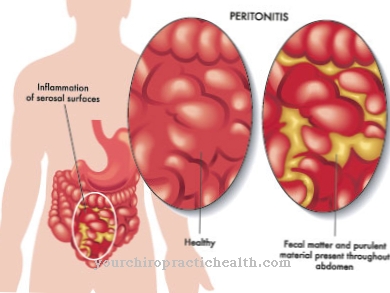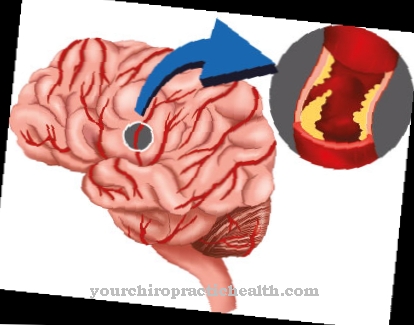Under Histiocytoses are understood to mean abnormal increases in white blood cells. The most common histiocytosis is Langerhans cell histiocytosis.
What is histiocytosis?

© Robert Kneschke - stock.adobe.com
At Histiocytoses These are rarely occurring different forms of disease in which there is a pathological increase in special white blood cells, which are known as histiocytes. Most patients suffer from Langerhans cell histiocytosis (LCH), also known as histiocytosis X.
Other forms are Erdheim-Chester disease, juvenile xantogranuloma and Rosai-Dorfman disease. While juvenile xanthogranuloma and Rosai-Dorfman disease usually take a benign course, Erdheim-Chester disease affects several organs and the skeleton.
Even the brain can be affected. Therefore, this form of histiocytosis is considered life-threatening. As already mentioned, Langerhans cell histiocytosis is the most common form of histiocytosis. Every year around 40 to 50 children in Germany develop this form of histiocytosis, which is also known as Abt-Letter-Siwe syndrome, Hand-Schüller- Christian syndrome or eosinophilic granuloma.
Between 70 and 80 percent of the sick children are younger than ten years. In adults, histiocytosis is much less common, although it is suspected that its frequency is estimated to be too low.
causes
Histiocytoses represent diseases of the monocyte / macrophage system. These are body cells that form in the bone marrow and occur in all organs. They are important to ward off substances that are foreign to the body. The various histiocytoses have in common that the histiocytes multiply pathologically in one or different organs.
The causes of the histiocytosis are unknown. Langerhans cell histiocytosis is not inherited and is not contagious. It almost always shows up in childhood. However, the incidence of the disease among adults has increased in recent years. Langerhans cell histiocytosis can be subdivided into three subforms.
These are the Abt-Letter-Liwe syndrome, which usually shows up in babies and young children, the Hand-Schüller-Christian syndrome, which predominantly occurs in young children, and the eosinophilic granuloma, which develops on the bones and develops between the age of 5 . and 20 years of age.
Symptoms, ailments & signs
The symptoms associated with histiocytosis are manifold. However, there are similar complaints, which can be used to obtain information about the disease. The most common general symptoms include pain in the affected parts of the body, exhaustion, fever, visual disturbances such as squint or bulging eyes, the increased incidence of infections, cough, breathing problems, severe thirst and chronic otitis media.
In addition, the patients suffer from swelling, pale skin, diarrhea, urine loss, growth disorders, swollen gums and loose teeth, which often fall out. In addition, rashes similar to diaper eczema develop on the skin. Langerhans cell histiocytosis is basically counted among the benign diseases.
In some cases, however, its course can be so severe that it becomes life-threatening. In adult patients, there is often isolated involvement of the lungs or of individual bones. However, multifocal outbreaks are possible with them too.
Diagnosis & course of disease
With so many different symptoms, it is not always easy to diagnose histiocytosis. Misdiagnoses are not uncommon, especially in the initial phase. However, if the suspicion of the disease is confirmed, a tissue removal (biopsy) takes place. During the analysis, a clear distinction must be made between Langerhans cell histiocytosis and the other forms.
Other examination methods include making x-rays and computed tomography (CT). The X-ray examination can be used to determine the breakdown of bones, while the involvement of the lungs is diagnosed with the computed tomography. An important clue for the diagnosis of histiocytosis X is the detection of a flat vertebra.
Langerhans cell histiocytosis takes a positive course in most patients. If the disease becomes chronic, it can lead to problems with the spine or loss of teeth. Some babies do not respond to treatment, which can make the condition life-threatening.
Ultimately, no definitive statement can be made about a positive or negative outcome at the start of therapy, so that each child is an individual case. Basically, the healing rate is around 70 percent.
Complications
As a result of histiocytosis, the person concerned suffers from various complaints that drastically reduce the quality of life and significantly limit the patient's everyday life. As a rule, there is a reduced resilience and severe exhaustion of the patient. Furthermore, visual disturbances and hearing problems occur, whereby the affected person can go completely blind in the worst case. Middle ear infections are not uncommon.
Due to the weakened immune system, various diseases and infections are more common. Children may experience stunted growth and further delayed development of the body. The skin is usually covered with rashes and is relatively pale. In many cases, histiocytosis also leads to psychological upset or depression.
The treatment of histiocytosis usually depends on the affected area. Surgical interventions or various creams and ointments can be used to eliminate the symptoms of histiocytosis. Furthermore, the patient has to give up smoking, for example, so that the disease progresses positively. In some cases, life expectancy is limited by histiocytosis.
When should you go to the doctor?
If symptoms such as fever, fatigue, and visual disturbances are noticed, often associated with non-specific pain, the underlying condition may be histiocytosis. A doctor's visit is recommended if there are other typical symptoms such as breathing problems or severe thirst. If the symptoms increase in intensity and do not go away by themselves, a doctor must be called in. In any case, histiocytosis requires drug treatment. Therefore, sufferers with persistent symptoms should consult a doctor.
Medical advice is required at the latest when swelling, noticeably pale skin and swollen gums are noticed. As babies and toddlers are mostly affected, parents are advised to watch out for abnormalities, especially if other family members suffer from the disease. In the event of serious complications such as infections or cardiovascular problems, it is best to call the emergency services. In case of doubt, the emergency medical service can be contacted first. The right contact person for histiocytosis is the family doctor or an angiologist. In the event of symptoms of teeth and gums, the dentist can be consulted.
Doctors & therapists in your area
Treatment & Therapy
The therapy of histiocytosis depends on the subform that occurs. For example, if the disease is limited to a single section of bone, there is the option of surgical removal of the focus. If the section is on a part of the body that is not suitable for an operation, such as a joint, radiation can be considered as an alternative.
If the histiocytosis occurs in multiple parts of the body, mild chemotherapy is carried out. If lymph nodes are affected, they can be surgically removed. Langerhans cell hystiocytosis can resolve itself in some patients without special treatment. If the skin is affected, however, the administration of cortisone is considered effective.
For this purpose, creams or ointments containing the active ingredient are applied to the affected areas of the skin. Adult patients with isolated lung involvement must consistently refrain from smoking. Study results showed that the nicotine contained in tobacco products triggers lung infection.
Unless the disease is severe, no further therapeutic measures are necessary. However, there are still differences of opinion among medical professionals. While children suffering from histiocytosis are treated in a university clinic, adult patients have to visit different specialists.
You can find your medication here
➔ Medicines for painOutlook & forecast
Children have the best chance of recovery from histiocytosis. Under favorable conditions, they are often free of symptoms. With a restructuring of living conditions and treatment, recovery can be documented for the majority of patients. Nevertheless, they can also develop a chronic course of the disease. This is especially true if the disease starts early. Problems of the spine or a loss of teeth are treated in various therapeutic approaches, but cannot be regenerated in the way they would work under natural conditions. In severe cases, the disease can become life-threatening. If the initiated therapy is unsuccessful, there is a risk of a steady increase in health impairments, which can end in fatal outcome.
In adults, the prognosis is generally more favorable. Life is only rarely endangered or the expected lifetime is shortened. If the doctor's instructions are adhered to and smoking is not completely avoided, extensive treatment can significantly alleviate the symptoms. Some patients already experience a significant improvement by changing their lifestyle.
If the disease is in the early stages, the patient often does not need to undergo medical treatment. A natural regeneration of the symptoms takes place, so that the patient is then released from the treatment as cured.
prevention
Histiocytosis cannot be prevented because it is inherited. In addition, their triggering causes are not known.
Aftercare
As a rule, the affected person has either very few or no measures and options available for follow-up care. In any case, those affected are dependent on early and, above all, rapid diagnosis and treatment so that further complications or complaints can be prevented. Self-healing cannot occur, so treatment must always be carried out.
An early diagnosis with rapid treatment always has a very positive effect on the further course of this disease. In many cases, the histiocytosis is treated with an operative intervention. After such an operation, the person concerned should definitely take it easy and rest. Exertion or other physical and stressful activities should be avoided.
In many cases, a healthy lifestyle with a healthy diet also has a positive effect on the course of the disease. If possible, the person affected should also refrain from smoking and alcohol. Regular examinations of the body are also necessary in order to identify further damage to the body at an early stage. It is not uncommon for histiocytosis to reduce the life expectancy of those affected.
You can do that yourself
Histiocytosis is always treated depending on the respective subform. Which measures those affected can take themselves depends on whether only a single section of bone is affected by the disease or several parts of the body.
Langerhans cell hystiocytosis sometimes resolves on its own. The most important measure then is to have the blood values monitored by a doctor in order to be able to react quickly in the event of a relapse. In the case of widespread disease, chemotherapy is necessary, which can be supported by a healthy lifestyle. Further exposure to nicotine or alcohol should be avoided, solely because of the risk of interactions with the cytostatics used. If the lungs are infected, it is particularly important not to smoke. Furthermore, rest and relaxation apply during and after chemotherapy, whereby exercise is permitted in moderation and with the consent of the doctor.
Those affected can also take action against the individual symptoms of histiocytosis. Rashes and eczema can be relieved through increased hygiene and the use of suitable ointments. Drinking a lot helps against strong thirst. Breathing problems and coughing attacks can be reduced by inhaling a salt water solution. The doctor in charge is best able to answer which measures are particularly useful.

.jpg)
.jpg)










.jpg)

.jpg)
.jpg)











.jpg)